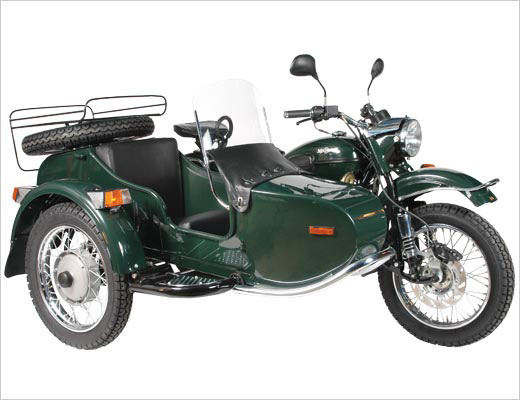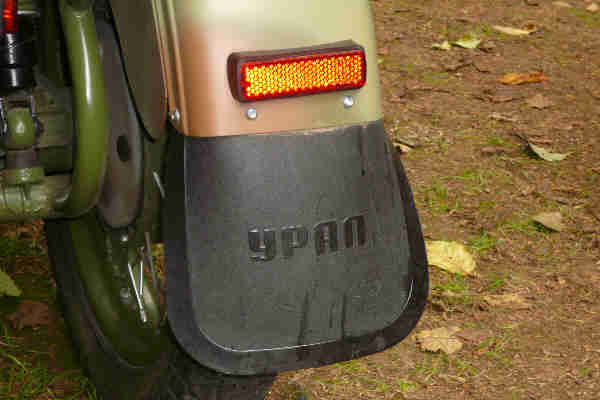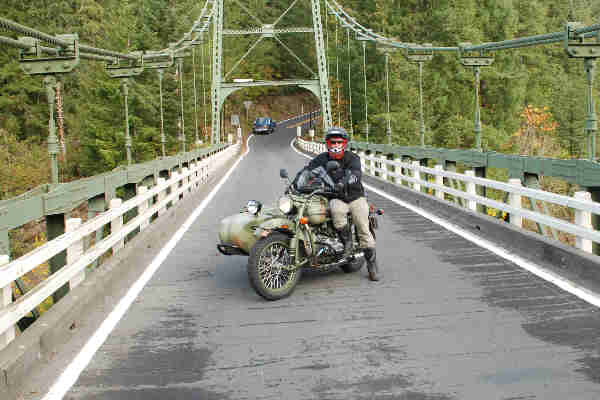| Author | Message | ||
Zane |
There was a strange bike in the parking garage this morning. It was badged as a Ygar. Engine cylinders 180 degrees opposed like some BMWs with carbs mounted right at the cylinders. It has big tall skirt fenders front and rear with kind of narrow tires and wire spoke rims. Medium flat seat with exposed rear springs. It also was set up with a side car that looked like it was straight out of WWII. Has anybody ever heard of a bike like this? I don't even have clue about a m/c like this. | ||
Elvis |
Never heard of Ygar, but Ural has the 180 degree boxer configuration. Could Ygar be a model Ural? | ||
Froggy |
I agree, sounds like Ural?  | ||
Xl1200r |
Keep in mind that a lot of Soviet factories made these BMW knock-offs after the war. We only know Ural because they're the only one left, but I think Dnper was actually the largest (at least at one point). There were also a collection of other smaller factories producing the same bikes off the same designs. It definately sounds like a WWII-era BMW clone, and the name is most definately Russian, so I'd guess it came from one of these other factories. | ||
Elvis |
Good point Xl. Could be the motorcycle equivalent of a Yugo at the time, but it would certainly be a conversation piece now. | ||
Jaimec |
Red China was selling BMW reproductions. I remember some guy coming to our dealership years ago asking if we'd like to carry the line. I believe he was "politely" laughed off the showroom floor... | ||
Jaimec |
How about "Ural" in Cyrillic letters? http://russian.speak7.com/russian_alphabet.htm | ||
Elvis |
Mystery Solved!! Very cool! I had guessed it might be something like that, but had no idea where to go to confirm it. Thanks Jaime! | ||
Jaimec |
I'll pass that along to my Estonian friend who pointed out that page of Cyrillic letters. | ||
Zane |
Froggy, The picture you posted looks very much like what is in the garage right now. Don't know how something like that would handle but it's got a Deals Gap decal on it. (Message edited by Zane on August 05, 2008) | ||
Spatten1 |
F'ing Jamie does it again. Impressive. | ||
Jaimec |
Don't know how something like that would handle but it's got a Deals Gap decal on it. Slowly! | ||
Regkittrelle |
I spent an, uh, entertaining 600 miles on one last Fall in Washington. Definitely an acquired taste.  This model is called the "Gear Up."  | ||
Zane |
Since it was designed and built in Russia can we say it has "Fine European Styling"? But you could say the same thing about a T-34 Russian medium tank. | ||
Xl1200r |
Zane - designed in Germany. This was one of the things the Russians took ownership of allies beat the germans into the ground after WWII. | ||
Regkittrelle |
Here's Ural's version of its history: The Ural story begins in 1939, during the USSR's pre-World War II planning. Despite the Molotov/von Ribbentrop Pact, the Soviet Union knew it would soon be going to war against Adolf Hitler, the ruthless dictator of the German Third Reich. Joseph Stalin ordered the military to prepare all areas of operation, including the ground forces that would defend the Russian motherland against invading German Panzers, ground troops, and Special Forces. Having seen the effects of the Blitzkrieg against the Polish Army, mobilization was of paramount importance to the USSR. A meeting was held at the USSR Defense Ministry to discuss what motorcycle model was most suitable for the Red Army. The Army had wanted to modernize its equipment after termination of the military conflict with Finland, as the motorcycles it had been using had not worked satisfactorily. Their technology was out-dated and the manufacturing quality left much to be desired. The official version reads that, after long discussion and debate, the BMW R71 motorcycle was decided to most closely match the Red Army's requirements. Five units were covertly purchased through intermediaries in neutral Sweden and smuggled to Russia. Soviet engineers in Moscow busily dismantled the 5 BMWs. They copied every detail of the BMW design and made moulds and dies to produce their own engines and gearboxes in Moscow. Everything about the bike was reverse engineered. Early in 1941, the first trial samples of M-72 motorcycles were shown to Stalin, who immediately approved production of the motorcycles. (Incidentally, one of these original BMWs survives and is on display at the factory museum. Harley-Davidson also copied the BMW design, and delivered about 1,000 Harley-Davidson XA (Experimental Army) flat-twin shaft drive motorcycles to the US Army during World War II. Meanwhile, in Japan, Riyushko was busy copying Harley-Davidson V twins!) A more likely story is that the BMW factory supplied the construction drawings and casting moulds. As a result of the Molotov / Ribbentrop Pact, transfers of technology had taken place in support of their Soviet "friends" in different areas. Soviet engineers toured German aircraft factories and brought back complete cannons as samples. The OPEL Kadett was given to the Soviets just prior to the war; however, it commenced series production only toward the end of the war as the Moskvitch 400. In 1941, BMW began series production of R75, and did not resume production of R71. Supplying the Soviets with the superceded R71 model may have seemed a good idea at the time. A factory in Moscow was soon producing hundreds of Russian M-72 sidecar motorcycles. The Nazi Blitzkrieg was so fast and effective that Soviet strategists worried that the Moscow factory was within easy range of German bombers. It was decided to move the motorcycle plant further east, out of bombing range, into the middle of the resource rich Ural Mountain region. The chosen site was the small trading town of Irbit, located on the fringe of the vast Siberian steppes in the Ural Mountains. Irbit had, before the Revolution of 1917, been an important Trade and Fair center in Russia. The only substantial building in town was a brewery. It was soon converted into research and development headquarters, where long hours were spent preparing for the construction of a massive new production complex for the M-72. On October 25, 1942, the first M-72s were sent into battle. Over the course of World War II, 9,799 M-72 motorcycles were delivered to the front for reconnaissance detachments and mobile troops. (Shortly after World War II, large hubcaps were produced for a new model under development. This new model, called the Glock, was never made due to copyright laws. The hubcaps were eventually donated to nearby zoos, where they became playthings for the monkeys.) The history of Ural began with the glory of helping to defeat the terror of Hitler's armies on the Russian and European battlefields. After World War II the Factory was renovated, and in 1950, the 30,000th motorcycle was produced. In the late 1950s, a plant in the Ukraine took over the manufacture of Urals for military use, and the Irbit Motorcycle Works (IMZ) began to build Urals for domestic, civilian consumption. The popularity of the outfits grew steadily among Russians, and in the 1960s, the plant was turned over to full non-military production. The export history of URALs started in 1953 The first Urals were exported in 1953, at first mainly to developing countries. In the late 1960s, deliveries to developed countries began, and since then more and more Urals have appeared on the road on every continent. Urals are a unique combination of price, ageless styling, and sidecar functionality. In November 1992, the State-owned factory transformed into Uralmoto Joint Stock Company. Uralmoto was a privatized entity, 40% of which was divided among management and employees through a grant, 38% of which was sold by auction with privatization vouchers (which went mostly to management and employees), and 22% of which was retained by the government. In early 1998, Ural was bought by private Russian interests; it is no longer a State-owned company. (Shortly after the purchase, in 2000, the government shares were redistributed to investors.) New ownership has brought new management, fresh ideas and production techniques, modernized design and updated technology, and above all, a commitment to quality control at all points of production. Ural motorcycles have been given a new lease on life. While the outward appearance of the engine retains the look of a classic Ural, quality control techniques and use of better alloying and casting, better engineering tolerances, better paint and chrome, make for a stronger, better bike. Everything good and unique about the old Urals has been maintained, including the inherently balanced design of a horizontally opposed flat twin engine with roller bearings in a solid frame. The main bike models built in the plant today are the heavy-duty Ural sidecar motorcycles, designed with rough Russian roads in mind, and the custom Wolf. There are many places in Russia where only horses and Ural motorcycles can be used to transport gear where you need it. Ural motorcycles are equipped with four-stroke air-cooled flat-twin engines, a four-speed gearbox with reverse gear, shaft drive, two disc dry clutch, spring shock absorbers, and drum brakes. New solo and sidecar models have been developed recently to better suit the tastes of Western markets. Ural is the only Russian manufacturer of heavy capacity motorcycles, and one of few manufacturers of sidecar motorcycles in the world. Besides sales of Ural motorcycles on the Russian market, they have also been exported to Australia, Britain, the United States, France, the Netherlands, Belgium, Spain, Greece, Norway, Finland, Sweden, Germany, Egypt, Iran, South Africa, Brazil, Uruguay, Paraguay, and numerous other countries. Over 3.2 million motorcycles have been delivered since the first M-72 rolled off the production floor. | ||
Jaimec |
It's the PERFECT bike for the annual Crotona Midnight Run. | ||
Zane |
Regkittrelle Now that really is interesting. I love history and that was a great lesson. Thanks! | ||
Jaimec |
| ||
Regkittrelle |
Zane... Thanx, but can't take credit for that; it's a cut 'n paste from the Ural web site. | ||
Xl1200r |
(Shortly after World War II, large hubcaps were produced for a new model under development. This new model, called the Glock, was never made due to copyright laws. The hubcaps were eventually donated to nearby zoos, where they became playthings for the monkeys.) So they were able to copy a BMW design to a T and get away with it, but adding hubcaps infringed on copywrite laws? Too funny, lol. | ||
Reepicheep |
Get Dave Barr's bike "Riding the Ice" for a first hand account of visiting the factory, and riding with some passionate builders and great riders of motorcycles for Russian roads. His sportster would not have made it without a few strategically placed Ural parts and repairs... | ||
U4euh |
Aftern watching that video, I peeked at Ebay to see what they were going for: http://cgi.ebay.com/ebaymotors/Ural-Tourist-Sideca r-New-2007-Ural-Tourist-Sidecar-Reverse-Gear-2-yr- Warrty_W0QQcmdZViewItemQQcategoryZ6717QQihZ006QQit emZ160267811469QQrdZ1QQsspagenameZWDVW Some good info from the dealer on that site. I wonder if a beemer motor of larger displacement could be spooned in that chassis. | ||
Doon |
They look pretty neat. I could totally see me getting something like that. 2WD would be different. Maybe I would then commute all year round (I don't like riding in snow on the Lightning  ) ) | ||
Corporatemonkey |
I have a short list of bikes that I am getting. The next one is a BMW k1200gt, then I am getting a Ural 2wd. The Ural will never leave the city, it will be my grocery getter. If you are really interested in a Ural talk to the "Mud Bug" he know the NA importers. | ||
Cityxslicker |
Ygar thats funny, but really made me spit coffee out my nose is "teach yourself russian in ten days" Good luck with that.  There is an orange camoflauged Ural sidecar that is on my list for winter acquisitions. | ||
Regkittrelle |
I found Ural's 2-wheel drive to be useless except in the most extreme stuck-in-the-mud conditions; bombing down a fire road in 2WD will end badly at the first turn; as you can imagine, the dynamics of having off-set driven wheels is strange. 55 mph is its comfort range... anything much more than than and the strain on the motor is obvious. On a positive note, I found it comfortable, fun in its own way, and well screwed. together | ||
Spiderman |
Were you able to turn the 2wd off and on? | ||
Regkittrelle |
Yes, there's a lever on the low, right side. My limited experience with sidecars has shown two things to be true: 1) Down-hill, right-hand turns in the wet can cause you to see your god 2) Proper alignment of bike and rig is essential | ||
Spiderman |
Sweeet... I am thinkin about getting a Dnper "do ti yourself" kit so i can ride it year round and finally take my bike to the rink with all my gear all year round  |